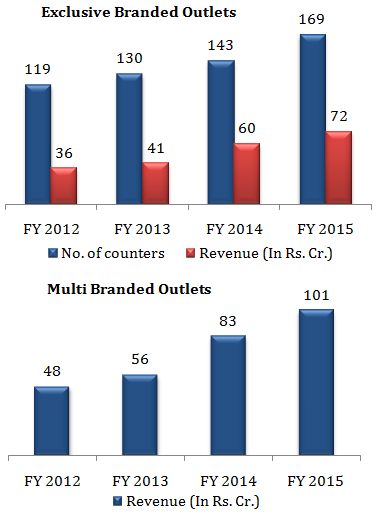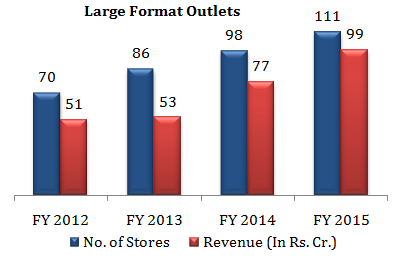Indian Terrain Fashions Limited (“Indian Terrain” or the “Company”) offer products in the premium casual wear range for men including jackets and winter wear products. The Company has 2 primary segments in apparel line; (i) woven, which include shirts, trousers, shorts, jeans; and (ii) non-woven, which include knitwear and jackets. The Company distributes its portfolio of products through EBOs’ (exclusive branded outlets, both company operated and franchisee operated), LFOs’ (large format outlets) and MBOs’ (multi-branded outlets).
What’s Positive for the Stock?
Strong Financial Position
Indian Terrain has shown consistent growth over the last five years (i.e. 2010-11 to 2014-15). It’s net revenue from operations over this period grew at an impressive CAGR of 19.05 %. For 9 months period ended FY 2016, income from operations increased by 4 % to Rs. 228.49 Cr. from Rs. 221.44 Cr. and PAT increased by 87 % to Rs. 26.20 Cr. from Rs. 13.98 Cr. Indian Terrain has reserves in excess of Rs. 126.40 Cr and operates with ZERO debt on its books. This strong financial position enables the Company to have bigger marketing and advertising budgets to attract more customers. With continuous increase in the number of outlets, and steady margins, earnings could grow significantly in the coming years.
Strong Distribution Network
Indian Terrain has established a pan-India distribution network spread across more than 200 cities in India through a diversified mix of EBOs, LFOs like Shoppers Stop, Lifestyle, Central, Westside and Globus and MBOs. The Company currently operates through 111 EBOs’, 169 counters in LFOs’, and more than 700 MBOs’. The Company is also present in the digital space through e-commerce platforms like Myntra, Flipkart and Jabong. Indian Terrain also has its own online store http://shop.indianterrain.com/ operated by the Company.
Increasing Acceptance of Ready-To-Wear Products
Rising disposable income coupled with the increasing awareness of international fashion trends have provided a strong growth to the men’s apparel market in the last few years. The men’s apparel segment reported an annual growth rate of 10% over 2010-2015 growing from $13 billion currently to $19 billion and is estimated to record 8% growth by FY 2020.
Increasing preference for casual wear and rising acceptance of ready-to-wear products helped the companies like Indian Terrain in creating significant differentiation from the local mom & pop textile stores.
Diversified Product Portfolio
The Company has positioned itself as a premium, smart casuals’ brand, targeting the working class in the age group of 25 – 44 year, with its products ranging from shirts, trousers, jackets, shorts, and knitwear. Indian Terrain product portfolio is dominated by shirts, trousers and t-shirts.
Asset Light business model
Indian Terrain follows an asset light model, whereby the Company outsources its manufacturing to known outsourced manufacturers with good track record. By employing an asset light model of operation, the Company does not required to invest large amount of capital into procurement of land, machinery or human resources. This outsourced model also results in maintain high RoCEs of +20%.
What’s Negative for the Stock?
Intense Competition
While the Company has an established itself in the branded apparel segment of readymade garment industry, it faces stiff competition from brands such as Peter England, Van Heusen, and Louis Philippe, Levi’s, Lee Copper, Arrow, Tommy Hilfiger and several other brands which dominates the menswear market in the country.
Pledged Promoter Holding
68.97% of promoter holding is pledged.
Higher the pledging of promoter’s share, greater could be the risk of volatility in the company’s share price. This is because, as share prices fall, the overall value of the pledged shares falls. This would put pressure on the promoter to produce more shares as collateral. Sometimes, the lender may also be forced to sell some of the shares to ensure that the loan does not turn into a bad loan. If the promoter is unable to meet obligations of borrowing, the ownership of shares is transferred to the lender, who may then sell it to recover loans.



